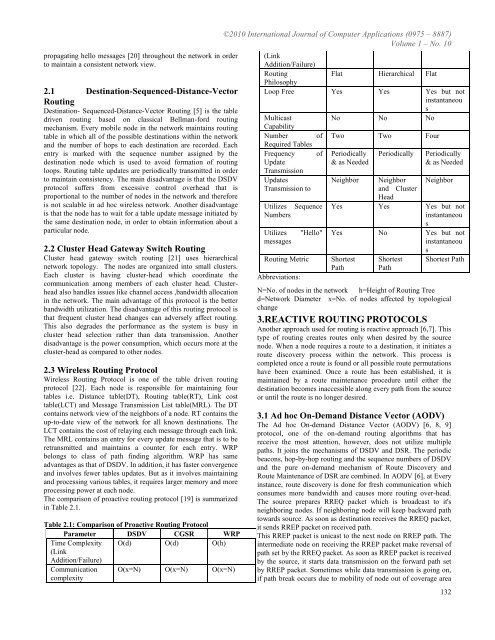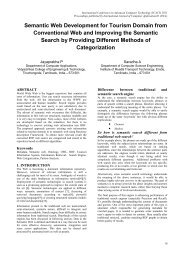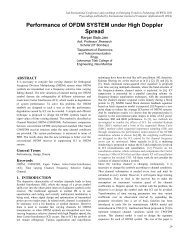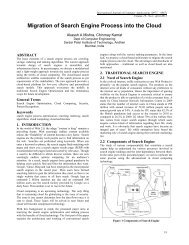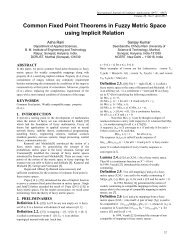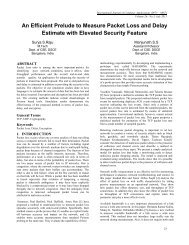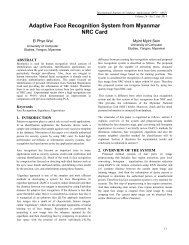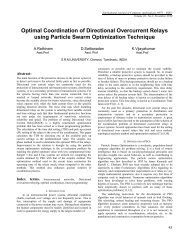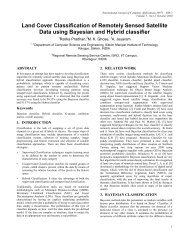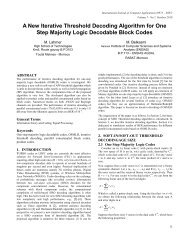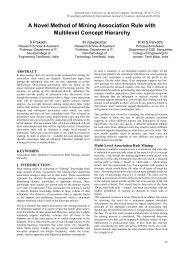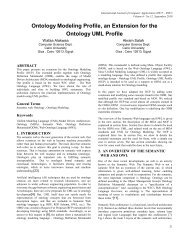Proceedings Template - WORD - International Journal of Computer ...
Proceedings Template - WORD - International Journal of Computer ...
Proceedings Template - WORD - International Journal of Computer ...
Create successful ePaper yourself
Turn your PDF publications into a flip-book with our unique Google optimized e-Paper software.
propagating hello messages [20] throughout the network in order<br />
to maintain a consistent network view.<br />
2.1 Destination-Sequenced-Distance-Vector<br />
Routing<br />
Destination- Sequenced-Distance-Vector Routing [5] is the table<br />
driven routing based on classical Bellman-ford routing<br />
mechanism. Every mobile node in the network maintains routing<br />
table in which all <strong>of</strong> the possible destinations within the network<br />
and the number <strong>of</strong> hops to each destination are recorded. Each<br />
entry is marked with the sequence number assigned by the<br />
destination node which is used to avoid formation <strong>of</strong> routing<br />
loops. Routing table updates are periodically transmitted in order<br />
to maintain consistency. The main disadvantage is that the DSDV<br />
protocol suffers from excessive control overhead that is<br />
proportional to the number <strong>of</strong> nodes in the network and therefore<br />
is not scalable in ad hoc wireless network. Another disadvantage<br />
is that the node has to wait for a table update message initiated by<br />
the same destination node, in order to obtain information about a<br />
particular node.<br />
2.2 Cluster Head Gateway Switch Routing<br />
Cluster head gateway switch routing [21] uses hierarchical<br />
network topology. The nodes are organized into small clusters.<br />
Each cluster is having cluster-head which coordinate the<br />
communication among members <strong>of</strong> each cluster head. Clusterhead<br />
also handles issues like channel access ,bandwidth allocation<br />
in the network. The main advantage <strong>of</strong> this protocol is the better<br />
bandwidth utilization. The disadvantage <strong>of</strong> this routing protocol is<br />
that frequent cluster head changes can adversely affect routing.<br />
This also degrades the performance as the system is busy in<br />
cluster head selection rather than data transmission. Another<br />
disadvantage is the power consumption, which occurs more at the<br />
cluster-head as compared to other nodes.<br />
2.3 Wireless Routing Protocol<br />
Wireless Routing Protocol is one <strong>of</strong> the table driven routing<br />
protocol [22]. Each node is responsible for maintaining four<br />
tables i.e. Distance table(DT), Routing table(RT), Link cost<br />
table(LCT) and Message Transmission List table(MRL). The DT<br />
contains network view <strong>of</strong> the neighbors <strong>of</strong> a node. RT contains the<br />
up-to-date view <strong>of</strong> the network for all known destinations. The<br />
LCT contains the cost <strong>of</strong> relaying each message through each link.<br />
The MRL contains an entry for every update message that is to be<br />
retransmitted and maintains a counter for each entry. WRP<br />
belongs to class <strong>of</strong> path finding algorithm. WRP has same<br />
advantages as that <strong>of</strong> DSDV. In addition, it has faster convergence<br />
and involves fewer tables updates. But as it involves maintaining<br />
and processing various tables, it requires larger memory and more<br />
processing power at each node.<br />
The comparison <strong>of</strong> proactive routing protocol [19] is summarized<br />
in Table 2.1.<br />
Table 2.1: Comparison <strong>of</strong> Proactive Routing Protocol<br />
Parameter DSDV CGSR WRP<br />
Time Complexity O(d) O(d) O(h)<br />
(Link<br />
Addition/Failure)<br />
Communication<br />
complexity<br />
O(x=N) O(x=N) O(x=N)<br />
©2010 <strong>International</strong> <strong>Journal</strong> <strong>of</strong> <strong>Computer</strong> Applications (0975 – 8887)<br />
Volume 1 – No. 10<br />
(Link<br />
Addition/Failure)<br />
Routing<br />
Flat Hierarchical Flat<br />
Philosophy<br />
Loop Free Yes Yes Yes but not<br />
instantaneou<br />
s<br />
Multicast<br />
No No No<br />
Capability<br />
Number <strong>of</strong> Two Two Four<br />
Required Tables<br />
Frequency <strong>of</strong><br />
Update<br />
Transmission<br />
Updates<br />
Transmission to<br />
Utilizes Sequence<br />
Numbers<br />
Utilizes<br />
messages<br />
Routing Metric<br />
Abbreviations:<br />
"Hello"<br />
Periodically<br />
& as Needed<br />
Periodically<br />
Periodically<br />
& as Needed<br />
Neighbor Neighbor<br />
and Cluster<br />
Head<br />
Neighbor<br />
Yes Yes Yes but not<br />
instantaneou<br />
s<br />
Yes No Yes but not<br />
instantaneou<br />
s<br />
Shortest<br />
Path<br />
Shortest<br />
Path<br />
Shortest Path<br />
N=No. <strong>of</strong> nodes in the network h=Height <strong>of</strong> Routing Tree<br />
d=Network Diameter x=No. <strong>of</strong> nodes affected by topological<br />
change<br />
3.REACTIVE ROUTING PROTOCOLS<br />
Another approach used for routing is reactive approach [6,7]. This<br />
type <strong>of</strong> routing creates routes only when desired by the source<br />
node. When a node requires a route to a destination, it initiates a<br />
route discovery process within the network. This process is<br />
completed once a route is found or all possible route permutations<br />
have been examined. Once a route has been established, it is<br />
maintained by a route maintenance procedure until either the<br />
destination becomes inaccessible along every path from the source<br />
or until the route is no longer desired.<br />
3.1 Ad hoc On-Demand Distance Vector (AODV)<br />
The Ad hoc On-demand Distance Vector (AODV) [6, 8, 9]<br />
protocol, one <strong>of</strong> the on-demand routing algorithms that has<br />
receive the most attention, however, does not utilize multiple<br />
paths. It joins the mechanisms <strong>of</strong> DSDV and DSR. The periodic<br />
beacons, hop-by-hop routing and the sequence numbers <strong>of</strong> DSDV<br />
and the pure on-demand mechanism <strong>of</strong> Route Discovery and<br />
Route Maintenance <strong>of</strong> DSR are combined. In AODV [6], at Every<br />
instance, route discovery is done for fresh communication which<br />
consumes more bandwidth and causes more routing over-head.<br />
The source prepares RREQ packet which is broadcast to it's<br />
neighboring nodes. If neighboring node will keep backward path<br />
towards source. As soon as destination receives the RREQ packet,<br />
it sends RREP packet on received path.<br />
This RREP packet is unicast to the next node on RREP path. The<br />
intermediate node on receiving the RREP packet make reversal <strong>of</strong><br />
path set by the RREQ packet. As soon as RREP packet is received<br />
by the source, it starts data transmission on the forward path set<br />
by RREP packet. Sometimes while data transmission is going on,<br />
if path break occurs due to mobility <strong>of</strong> node out <strong>of</strong> coverage area<br />
132


